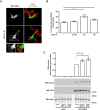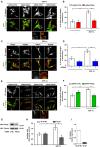The diacylglycerol kinase α/atypical PKC/β1 integrin pathway in SDF-1α mammary carcinoma invasiveness
- PMID: 24887021
- PMCID: PMC4041662
- DOI: 10.1371/journal.pone.0097144
The diacylglycerol kinase α/atypical PKC/β1 integrin pathway in SDF-1α mammary carcinoma invasiveness
Abstract
Diacylglycerol kinase α (DGKα), by phosphorylating diacylglycerol into phosphatidic acid, provides a key signal driving cell migration and matrix invasion. We previously demonstrated that in epithelial cells activation of DGKα activity promotes cytoskeletal remodeling and matrix invasion by recruiting atypical PKC at ruffling sites and by promoting RCP-mediated recycling of α5β1 integrin to the tip of pseudopods. In here we investigate the signaling pathway by which DGKα mediates SDF-1α-induced matrix invasion of MDA-MB-231 invasive breast carcinoma cells. Indeed we showed that, following SDF-1α stimulation, DGKα is activated and localized at cell protrusion, thus promoting their elongation and mediating SDF-1α induced MMP-9 metalloproteinase secretion and matrix invasion. Phosphatidic acid generated by DGKα promotes localization at cell protrusions of atypical PKCs which play an essential role downstream of DGKα by promoting Rac-mediated protrusion elongation and localized recruitment of β1 integrin and MMP-9. We finally demonstrate that activation of DGKα, atypical PKCs signaling and β1 integrin are all essential for MDA-MB-231 invasiveness. These data indicates the existence of a SDF-1α induced DGKα - atypical PKC - β1 integrin signaling pathway, which is essential for matrix invasion of carcinoma cells.
Conflict of interest statement
Figures






Similar articles
-
Diacylglycerol kinase alpha mediates HGF-induced Rac activation and membrane ruffling by regulating atypical PKC and RhoGDI.Proc Natl Acad Sci U S A. 2010 Mar 2;107(9):4182-7. doi: 10.1073/pnas.0908326107. Epub 2010 Feb 16. Proc Natl Acad Sci U S A. 2010. PMID: 20160093 Free PMC article.
-
Diacylglycerol kinase-alpha mediates hepatocyte growth factor-induced epithelial cell scatter by regulating Rac activation and membrane ruffling.Mol Biol Cell. 2007 Dec;18(12):4859-71. doi: 10.1091/mbc.e07-02-0177. Epub 2007 Sep 26. Mol Biol Cell. 2007. PMID: 17898083 Free PMC article.
-
Biomaterial-enabled delivery of SDF-1α at the ventral side of breast cancer cells reveals a crosstalk between cell receptors to promote the invasive phenotype.Biomaterials. 2017 May;127:61-74. doi: 10.1016/j.biomaterials.2017.02.035. Epub 2017 Feb 27. Biomaterials. 2017. PMID: 28279922 Free PMC article.
-
Diacylglycerol Kinase alpha in X Linked Lymphoproliferative Disease Type 1.Int J Mol Sci. 2021 May 29;22(11):5816. doi: 10.3390/ijms22115816. Int J Mol Sci. 2021. PMID: 34072296 Free PMC article. Review.
-
Diacylglycerol Signaling Pathway in Pancreatic β-Cells: An Essential Role of Diacylglycerol Kinase in the Regulation of Insulin Secretion.Biol Pharm Bull. 2015;38(5):669-73. doi: 10.1248/bpb.b15-00060. Biol Pharm Bull. 2015. PMID: 25947912 Review.
Cited by
-
Diacylglycerol Kinases: Shaping Diacylglycerol and Phosphatidic Acid Gradients to Control Cell Polarity.Front Cell Dev Biol. 2016 Nov 29;4:140. doi: 10.3389/fcell.2016.00140. eCollection 2016. Front Cell Dev Biol. 2016. PMID: 27965956 Free PMC article. Review.
-
Diacylglycerol Kinases as Emerging Potential Drug Targets for a Variety of Diseases: An Update.Front Cell Dev Biol. 2016 Aug 17;4:82. doi: 10.3389/fcell.2016.00082. eCollection 2016. Front Cell Dev Biol. 2016. PMID: 27583247 Free PMC article. Review.
-
Epigenetic regulation of diacylglycerol kinase alpha promotes radiation-induced fibrosis.Nat Commun. 2016 Mar 11;7:10893. doi: 10.1038/ncomms10893. Nat Commun. 2016. PMID: 26964756 Free PMC article.
-
DGKα, Bridging Membrane Shape Changes with Specific Molecular Species of DAG/PA: Implications in Cancer and Immunosurveillance.Cancers (Basel). 2022 Oct 26;14(21):5259. doi: 10.3390/cancers14215259. Cancers (Basel). 2022. PMID: 36358678 Free PMC article. Review.
-
Molecular Pathways: Targeting Diacylglycerol Kinase Alpha in Cancer.Clin Cancer Res. 2015 Nov 15;21(22):5008-12. doi: 10.1158/1078-0432.CCR-15-0413. Epub 2015 Sep 29. Clin Cancer Res. 2015. PMID: 26420856 Free PMC article.
References
-
- Müller A, Homey B, Soto H, Ge N, Catron D, et al. (2001) Involvement of chemokine receptors in breast cancer metastasis. Nature 410: 50–56. - PubMed
-
- Teicher BA, Fricker SP (2010) CXCL12 (SDF-1)/CXCR4 pathway in cancer. Clin Cancer Res 16: 2927–2931. - PubMed
-
- Burger JA, Kipps TJ (2006) CXCR4: a key receptor in the crosstalk between tumor cells and their microenvironment. Blood 107: 1761–1767. - PubMed
Publication types
MeSH terms
Substances
Grants and funding
LinkOut - more resources
Full Text Sources
Other Literature Sources
Medical
Miscellaneous

